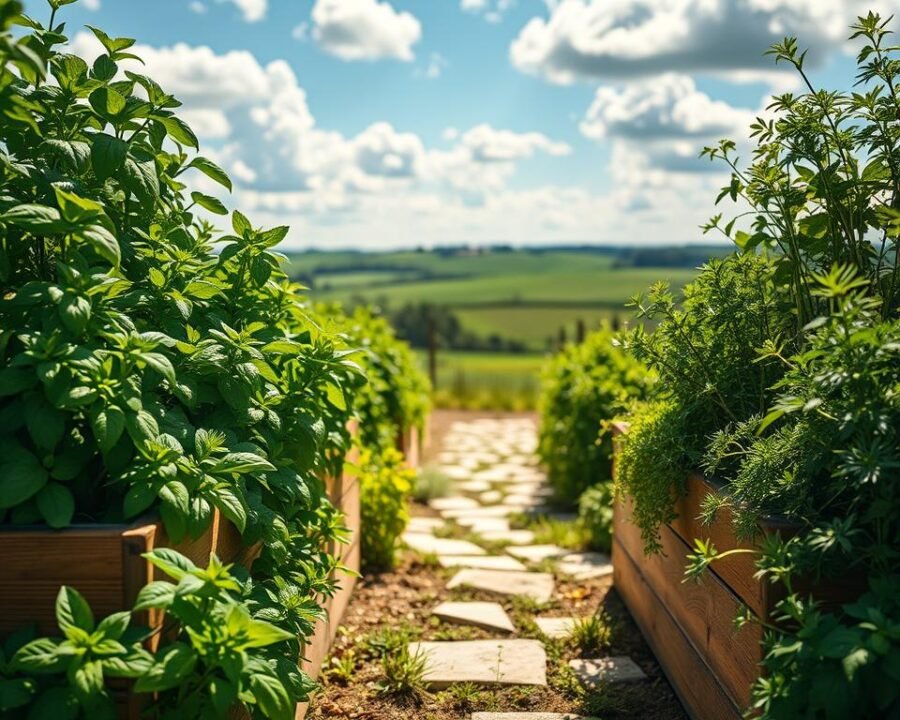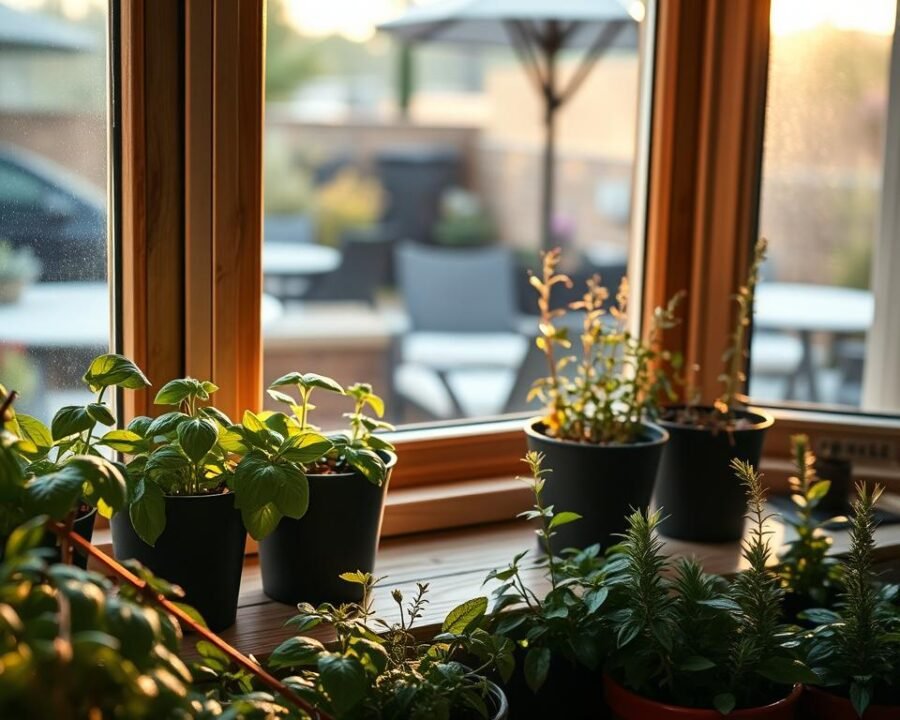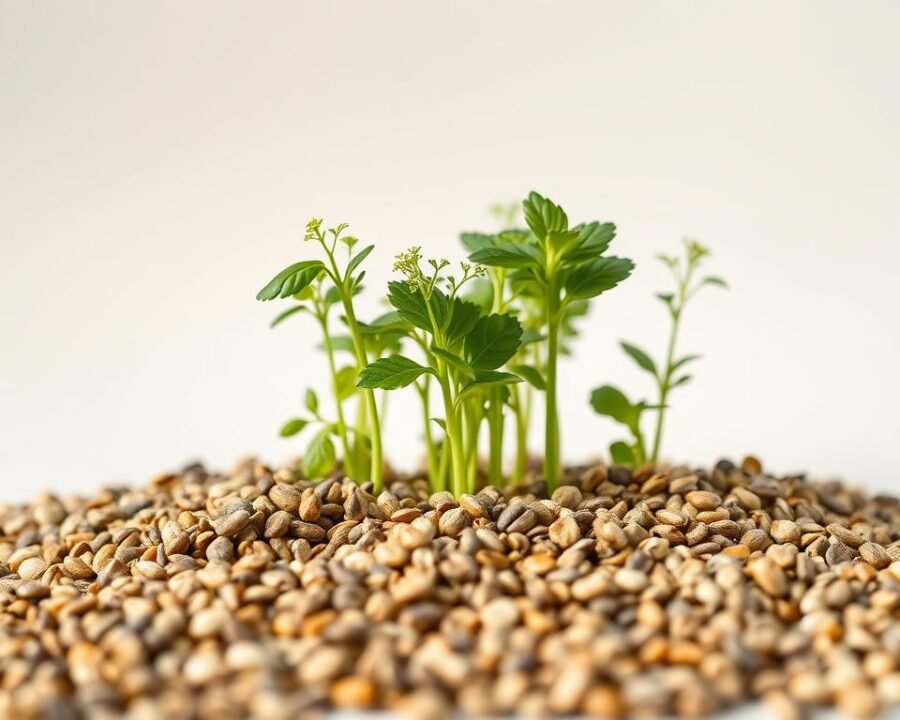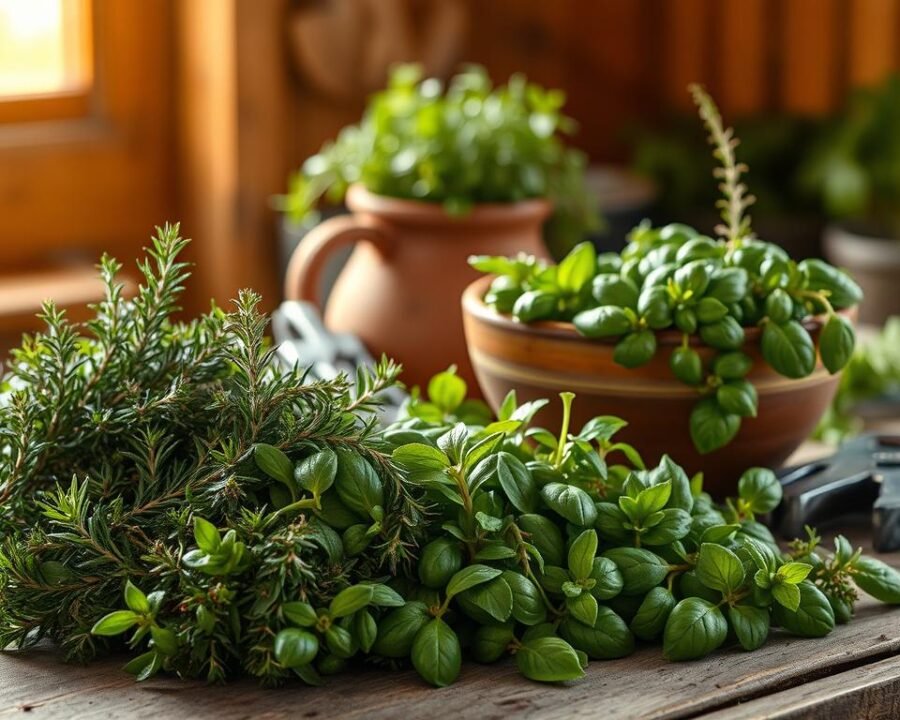There’s something magical about snipping fresh herbs straight from your garden or windowsill. The aroma fills the air, and the flavor elevates every dish. No more wilted store-bought bundles—just vibrant, lively plants ready to enhance your meals.
Whether you have a sprawling backyard or a sunny apartment ledge, cultivating your own herbs is simpler than you think. Imagine stepping into your kitchen, plucking a few leaves, and transforming ordinary recipes into culinary delights. It’s a small change with a big impact.
From peppery basil to fragrant rosemary, these little wonders thrive with minimal effort. No green thumb required—just enthusiasm and a love for fresh, bold tastes. Let’s explore how easy it is to bring nature’s best flavors right into your home.
Key Takeaways
- Freshly picked herbs offer unmatched taste compared to store-bought options.
- Even small spaces can support a thriving herb garden.
- Harvesting on demand ensures peak freshness for cooking.
- Beginner-friendly varieties like chives make gardening approachable.
- Homegrown herbs reduce reliance on grocery stores year-round.
Why Grow Your Own Herbs?
Plastic-wrapped supermarket herbs can’t compete with the vitality of your own harvest. A herb garden delivers unmatched taste, savings, and sustainability—all from your windowsill or backyard.
The Joy of Fresh Flavors at Your Fingertips
Homegrown fresh herbs pack three times the flavor of dried store versions. A single basil leaf can elevate pasta, while store-bought bunches often lose potency. You’ll use less for more impact.
Imagine garnishing dishes with just-picked mint or thyme. The brightness lingers, turning simple meals into chef-worthy creations. No more wilted, overpriced clamshells.
Cost-Effective and Eco-Friendly
Ditch the $3 grocery packs. Growing your own saves over $200 yearly. Better yet, you’ll slash plastic waste—no more tossing half-used bundles.
| Benefit | Homegrown | Store-Bought |
|---|---|---|
| Flavor Intensity | 3x stronger | Diminished by drying |
| Cost | $0 after initial setup | $3-$5 per bunch |
| Waste | Compost trimmings | Non-recyclable packaging |
Trimmed stems nourish your soil, creating a sustainable cycle. Every snip connects you deeper to the food on your plate. That’s the gardening life—fresh, cost-effective, and kind to the planet.
How to Grow Herbs Plant Everyone Is Using
Nothing beats the instant aroma of crushed basil leaves picked moments before cooking. For beginners, a few versatile varieties deliver big rewards with little fuss. Start with these forgiving favorites, and avoid tricky picks until you gain confidence.
Foolproof Favorites

Basil thrives in warmth—keep it near a sunny window. Pinch off flowers to encourage leafy growth. Pro tip: Start from seeds for a cost-effective supply.
Mint grows aggressively. Confine it to pots to prevent garden takeovers. Its refreshing leaves elevate drinks and salads effortlessly.
Thyme needs minimal water once established. Perfect for forgetful waterers, it adds earthy depth to roasted dishes.
Parsley outperforms cilantro indoors. As a biennial, it provides leaves longer with steady harvesting.
Herbs to Skip Initially
Rosemary demands cool temperatures and bright light. Without proper air circulation, it’s prone to powdery mildew indoors.
Sweet bay takes three years to mature into a harvestable bush. Beginners often lose patience before the first trim.
- Basil: Warmth + pinching = endless leaves.
- Mint: Isolate to control its spread.
- Thyme: Water sparingly for robust flavor.
- Parsley: A low-drama biennial star.
With these starters, growing herbs becomes a joyful habit. Build skills with easy wins, then explore advanced varieties later.
Choosing the Right Herbs for Your Space
Urban dwellers rejoice—herbs flourish in compact settings with the right choices. Whether you’re working with a sunny windowsill or a petite balcony, strategic picks like chives and oregano deliver big flavors without demanding acres of space.

Best Herbs for Small Spaces
Chives thrive in 6″ deep pots, their grassy shoots perfect for garnishing soups and salads. For vertical flair, try trailing oregano varieties in hanging planters—their roots roam freely in broad containers.
Design a windowsill garden with these space-savers:
- Oregano: Drought-tolerant and ideal for herbs indoors.
- Thyme: Compact and low-maintenance.
- Parsley: A biennial that keeps giving.
Indoor vs. Outdoor Growing
East- or west-facing windows provide ample sun for most varieties—just avoid north-facing spots for light-hungry mint. Outdoors, aim for 6+ hours of sunlight; indoors, 4 hours suffices.
| Factor | Indoor | Outdoor |
|---|---|---|
| Light Needs | 4 hours/day | 6+ hours/day |
| Space | Windowsill or shelf | Garden bed or large pot |
| Maintenance | Rotate pots weekly | Water during dry spells |
For aggressive growers like mint, drought-tolerant herbs outdoors benefit from buried container barriers. Indoors, weekly rotation prevents leggy growth.
Starting Your Herb Garden: Seeds vs. Plants
Fresh flavors begin with smart choices—should you sow seeds or buy established plants? The answer depends on the variety and your patience level. Some herbs flourish from tiny seeds, while others thrive best as nursery-started specimens.

Local Nurseries: The Hidden Advantage
Skip big-box stores for healthier starts. Independent nurseries often stock untreated varieties, free from synthetic fungicides that stunt growth. Their staff typically knows each plant’s history—ask about fertilizer use to ease the transition to organic care.
Spot quality thyme plants by their woody stems and earthy rootball scent. For sage, seek compact growth with no yellowing leaves. These details matter when establishing your garden’s foundation.
Herbs That Love Starting From Seed
Basil and dill sprout quickly, making them ideal for seed starters. Begin basil indoors 6 weeks before frost using heat mats for faster germination. Cilantro prefers direct sowing in deep pots with afternoon shade to prevent legginess.
- Baker Creek and Botanical Interests offer reliable seed varieties.
- Mix fine seeds like thyme with sand for even distribution.
- Anise and fennel resent transplanting—sow them directly.
Better Bought as Plants
Woody herbs like thyme and sage grow slowly from seeds. Nursery-grown plants give you a head start. Propagate sage from cuttings later to avoid annual purchases.
| Method | Best For | Tip |
|---|---|---|
| Seeds | Basil, dill, cilantro | Use heat mats for warmth-loving varieties |
| Plants | Thyme, sage, rosemary | Check for woody stems at the nursery |
For more transplanting insights, explore herb care guidelines from trusted horticulturists. Whether sowing or selecting, your efforts will soon yield fragrant rewards.
Soil and Containers: Setting Up for Success
Healthy roots start with the perfect foundation—your soil and containers make all the difference. The right mix and size ensure robust growth and intense flavors. Let’s dig into the essentials.
The Right Potting Mix for Flavorful Herbs
Skip generic garden soil. Mediterranean varieties like rosemary thrive in a 3:1 blend of organic potting mix and perlite. This combo prevents waterlogging while letting roots breathe.
Enrich with compost for nutrient-dense growth. Herbs deplete magnesium fast—refresh the soil yearly to maintain vitality. For wooden containers, line them with landscape fabric. It retains soil while allowing drainage.
Container Sizes: Avoiding Cramped Roots
Match the pot to the plant’s habits. Mint spreads via surface runners—opt for wide, shallow containers. Parsley’s taproots need depth; upgrade to a 10″ pot to prevent curling.
| Herb | Container Needs |
|---|---|
| Basil | 8″ diameter, 6″ deep |
| Thyme | 6″ wide, shallow |
| Parsley | 10″ deep for taproots |
Always choose containers 2″ wider than nursery pots. Tight quarters stunt growth—happy roots mean lush leaves.
Light and Water: The Basics of Herb Care
Bright flavors start with smart light and water choices. These elements work together to create vibrant leaves packed with essential oils. Whether indoors or out, mastering these fundamentals ensures year-round freshness.
Sunlight: Positioning for Peak Performance
Mediterranean varieties crave intense sun—place them within 6″ of south-facing windows. Mints prefer indirect light, thriving 2 feet back from the same glass. Cooler nights (50-60°F) help maintain compact growth.
Boost light efficiency with these tactics:
- Install reflective panels behind west-facing plants—increases light by 40%
- Rotate pots weekly for even exposure
- Use sheer curtains to filter intense afternoon sun
| Herb Type | Ideal Window | Daily Light Needs |
|---|---|---|
| Rosemary, thyme | South | 6+ hours |
| Mint, parsley | East/West | 4 hours |
Watering Wisdom: Timing Is Everything
Check soil moisture by inserting a finger to the second knuckle. Water only when dry for drought-loving varieties like thyme. This mimics their native arid conditions perfectly.
Room-temperature water prevents root shock during winter months. Cold liquids stress plants as much as sudden frosts.
Revive drooping mint with a 30-minute bottom-watering session. The technique hydrates roots without overwhelming delicate leaves. Always allow proper air circulation afterward to prevent mildew.
Seasonal Herb Gardening Tips
Seasonal shifts bring new opportunities for herb enthusiasts. With smart adjustments, we enjoy fresh flavors all year—even when temperatures drop. Whether nurturing heat-lovers in summer or sheltering tender varieties in winter, each phase offers unique rewards.
Thriving in Heat and Cold
Summer favorites like basil demand weekly harvesting to delay flowering. Mulch their roots with straw to shield against scorching soil. Meanwhile, winter savory thrives indoors when its annual cousin fades.
Consider these seasonal stars:
- Summer: Plant dill and cilantro in succession for continuous harvests
- Winter: Parsley withstands frost under row covers until 20°F
- Year-round: Rosemary adapts to both seasons with proper care
| Season | Herb | Special Care |
|---|---|---|
| Summer | Basil | Harvest weekly, mulch roots |
| Winter | Thyme | Prune woody stems pre-season |
| Transition | Rosemary | Acclimate on porch first |
Moving Inside Successfully
Transition outdoor herbs indoors over 7-10 days to prevent shock. Start by relocating containers to a shaded porch. This gradual shift helps plants adjust to lower light levels.
Essential steps for indoor transitions:
- Inspect for pests before bringing inside
- Trim leggy growth to encourage bushiness
- Supplement with grow lights when daylight dips below 9 hours
Woody-stemmed herbs like thyme benefit from pre-winter pruning. Removing older growth stimulates tender new leaves perfect for holiday cooking.
With these strategies, your garden transitions smoothly between seasons. Fresh flavors needn’t stop when the first frost arrives—they simply move closer to your kitchen.
Troubleshooting Common Herb Problems
Spotting trouble early keeps your herb garden thriving. Most issues stem from simple fixes—once you know what to look for. We’ll tackle frequent challenges and their straightforward solutions.
Dealing With Pests and Diseases
Powdery mildew appears as white dust on leaves, especially rosemary. Combat it with a milk spray—mix one part milk with nine parts water. Apply weekly until the disease disappears.
Spider mites leave tiny webs under leaves. Confirm their presence by tapping foliage over white paper. Neem oil treatments every five days stops infestations without harsh chemicals.
Reviving Wilted or Overwatered Plants
Soggy soil suffocates roots. For overwatered plants, replace the top two inches with dry potting mix. Terra cotta pots help basil recover faster—their porous walls improve air circulation.
Wilted mint perks up after a two-hour water bath. Let it drain completely, then place in shade for recovery. Always prune moldy stem sections one inch below damage, dusting cuts with cinnamon powder.
Prevent future issues with these pro tips:
- Position a small fan near indoor plants to discourage fungal growth
- Check soil moisture before watering—dry knuckle-deep means go ahead
- Isolate new plants for a week to prevent spreading pests
Conclusion: Enjoy Your Homegrown Herb Bounty
The joy of homegrown flavors transforms everyday meals into something special. With your thriving garden, each snip delivers fresh herbs bursting with unmatched aroma and taste.
Preserve excess harvests by freezing herb cubes or dehydrating leaves. Share divisions of mint or chives with neighbors—it’s a great way to build community while expanding your garden network.
Experiment with pairings like orange thyme in marinades. Track flavor intensity; morning harvests often pack more essential oils. Save seeds from bolted parsley to use next year.
From home kitchens to shared plots, these small steps yield big rewards. Let every dish celebrate the vibrant flavor of your care and creativity.
